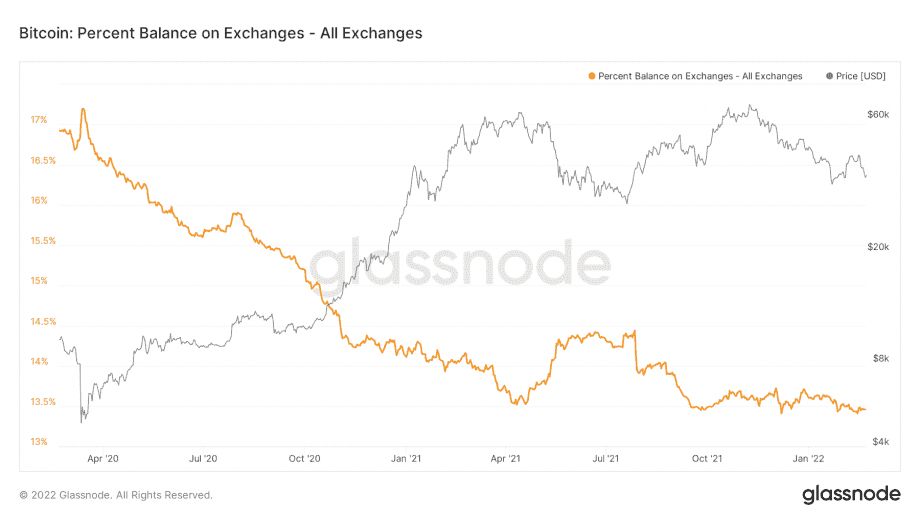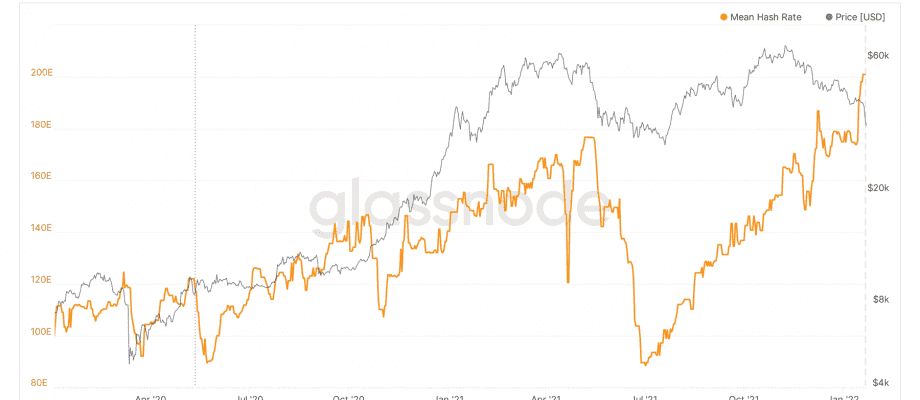Vladimir Putin recognized the separatist areas in eastern Ukraine in a one-hour speech yesterday and then sent troops to Luhansk and Donetsk as part of a “peacekeeping mission” – BTC-ECHO reported. Previously, there had been brief hopes of a meeting between US President Joe Biden and the Kremlin chief. However, those hopes were quickly dashed after the Kremlin denied them. Since the invasion, one thing has been clear: the diplomatic efforts have failed, at least for the time being.
Fear of war is spreading on the stock exchange. The DAX fell in after-hours trading by more than 3.5 percent to 14,215 points, but was able to stabilize again today. The Russian stock exchange barometer RTS, which includes the 50 largest Russian companies, recorded a real slide in prices. On Monday, following the Kremlin’s announcement, the currency slumped by around 13 percent and at the same time took the ruble with it, which lost three percent against the US dollar. The bond market was not unaffected either. The yield on 10-year Russian government bonds rose 0.8 percentage points to 10.6 percent.
Gold and oil up
There were also major distortions on the commodity and foreign exchange markets. Since Russia is one of the largest crude oil producers in the world, the price per barrel of North Sea Brent rose by two percent to over 95 US dollars. The price of the WTI (West Texas Intermediate) variety rose even more sharply and is currently around 3.7 percent up.
But in times of crisis there are also the usual winners. In addition to gold, this also includes supposedly safe havens such as US government bonds and the US dollar. The gold price was able to overcome the 1,900 US dollar relatively easily in the course of the increasing tightening and the silver price also gained around 3.5 percentage points on a weekly basis.
Bitcoin – a Safe Haven?
The effects of Putin’s decision in the Ukraine crisis are becoming more apparent on the crypto market. Bitcoin and Ethereum have meanwhile suffered losses of 6.3 and 8.2 percent, respectively. Currently, however, Bitcoin also seems to be finding support again and is trading more than two percent up at the time of writing.
After a significant improvement in sentiment in the past few weeks, fear is also returning to crypto investors. The fear and greed index, which is considered a good proxy for market sentiment, slipped into the range extreme fear off (see below). Among the top 10 cryptocurrencies, Solana and XRP were hit the hardest. Both recorded double-digit price declines.
The current situation underscores the old stock market adage that stock markets hate uncertainty. In such phases, all riskier securities are quickly liquidated. In addition to the tech highflyers, this also includes cryptocurrencies. A stronger correlation has already been observed in recent months. One reason for this could certainly be the increasing institutional commitment, because institutional investors quickly sell everything that is too risky in risk-off phases. Gold’s near-term outperformance versus bitcoin underscores the fact that bitcoin is not yet a safe-haven asset class at this point in time. However, one should not forget that Bitcoin and many altcoins have clearly outperformed all other asset classes over the longer term. The Bitcoin price has increased more than eightfold over a 3-year period. The market-wide index S&P 500 is up around 55 percent in the same period, the price of gold around 13 percent. The leading German index, the DAX, rose to around 28 percent during this period.
Anyone who invests in cryptocurrencies should always take the increased volatility into account. This can provide enormous tailwind in upswing phases, but exactly the opposite applies in risk-off phases.
Inflation: the sword of Damocles interest rate policy
Of course, the current situation is poison for the markets. However, investors should not forget that, economically speaking, Russia plays a rather subordinate role. Russia’s gross domestic product (GDP) was in 2021 $1.65 trillion. That sounds like a lot at first, but it is relatively little compared to global GDP.
A possible scenario that is currently being played out on the market is that sanctions against Russia, which also affect Russian energy supplies, could lead to rising energy prices in Europe. This was also emphasized by the Italian Prime Minister Mario Draghi last Friday, February 18, in a press conference.
We are discussing sanctions with the EU and in the course of these discussions we have expressed our position that they should focus on specific sectors without involving the energy sector.
Mario Draghi at a press conference, source: Reuters
The West has meanwhile announced sanctions against Russia and the separatist areas. The President of the European Commission, Ursula von der Leyen, threatened to exclude Russia from the international payment system SWIFT.
However, the real problem in the markets is still the interest rate policy of the global central banks – above all that of the fed – as well as looming recession fears. In January, U.S. inflation was up a whopping 7.5 percent yoy – BTC-ECHO reported. After the Fed had previously announced a much tighter monetary policy from March, the market praised an even faster and tighter action by the Fed after these record inflation data. The US Investment Bank JPMorgan meanwhile, even expects the US Federal Reserve to raise interest rates for nine consecutive meetings.
the ECB had recently stuck to its loose interest rate policy, but is also increasingly under fire due to the persistently high inflation data. While growth in Europe had recently been quite stable, the producer prices stronger than it has been since 1949.
As long as inflation does not fall noticeably, the Fed remains in a quandary. If it doesn’t raise interest rates fast enough, it runs the risk of inflation running too hot. On the other hand, there is a risk that it will stall the economy and create a recession.
Bitcoin: Bullish On-Chain Data
Political exchanges have short legs. You often hear this saying on the stock exchange, because it has often come true. Political turmoil notwithstanding, it’s important to remember that the big picture for bitcoin remains positive. Several on-chain indicators now point to this:
After China banned mining last year, the miners switched to other countries without further ado. The slump in summer 2021 was therefore short-lived. As can be seen in Figure 1, the hash rate increased again at the beginning of the new year and is now at an all-time high. The miners are thus proving that they are basically still bullish and are building up further mining capacities despite a falling Bitcoin price.
Figure 2 shows that the share of crypto holdings on the exchanges fell from around 17 percent to 13 percent over the year. A sign that many hodlers are increasingly transferring their coins from the trading platforms to cold storages. The result: the supply of available, tradable Bitcoin is steadily declining. The figure also makes it clear that it is above all (still) rather restrained demand that is preventing a stronger bull market. However, if the trend continues and demand increases sharply, the current situation would be extremely bullish for the Bitcoin price.



You want to buy Bitcoin (BTC)?
We show you the best providers where you can buy and sell Bitcoin in just a few minutes.
To the guide
